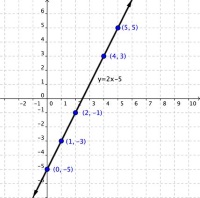Basics
Algebra uses letters(such as x or y) to denote numbers. These are called variables, as an example one can say x = 4 and use x as if it was actually the number 4. These numbers do not have to be equal to their original value, they can be changed. As an example we previously defined the variable x to be equal to 4, we can now say x = x + 1 and x would be equal to 5. We can define multiple variables such as x and y and make them dependant on each other. What I mean by this is we can say something like x = 7, and y = 2x, this can be interpreted as y = 2 * 7, we can therefore conclude that y = 14 when x = 7. Based on this we can create a graph where the number x represents how far across in the horizontal axis and y represents how far in the vertical axis. One example we can do is y = 2x - 5, this can be graphed as the following:
This is fairly straightforward, when x = 4 we can see that y = 3, or when x = 5, y = 5, all we have to do to solve this is substitute the value of x into y = 2x - 5.
Quadratics
A function can be very complex, let's say we have the following function: 2x2 + 3x + 5 = 0. This function could be re written with variable names as ax2 + bx + c, what if we wanted to figure out what x is equal to? There is a formula to solve for the value of x in situations like this, it's called the Quadratic Formula. The quadratic formula can be defined as follows: x = (-b ± sqrt(b2 - 4ac))/2a.Systems of Equations
A system of equations is a collection of 2 or more equations with the same set of unknown variables, one example of a system of equations is: one example would be:- 2x - 3y = -2
- 4x + y = 24
y = -4x + 24
Now that we have a function where y is dependant on x we can re-arrange the first function as follows:
2x - 3(-4x + 24) = -2
This is due to the fact that y = -4x + 24, so we can simply replace y in the first equation with something that only include 1 unknown variable, we can now solve it easily by solving each part:
2x + 12x - 72 = -2
14x = 70
x = 5
Matrices
A matrix is a 2 dimensional array of numbers, one example of a matrix would be:
A matrix can be of any size in either direction, the amount of values horizontally does not have to equal the amount of values in the vertical axis. To multiply a matrix we multiply rows by columns.

So the first row of the new matrix contains the first row of matrix A multiplied by all the columns of matrix B.
